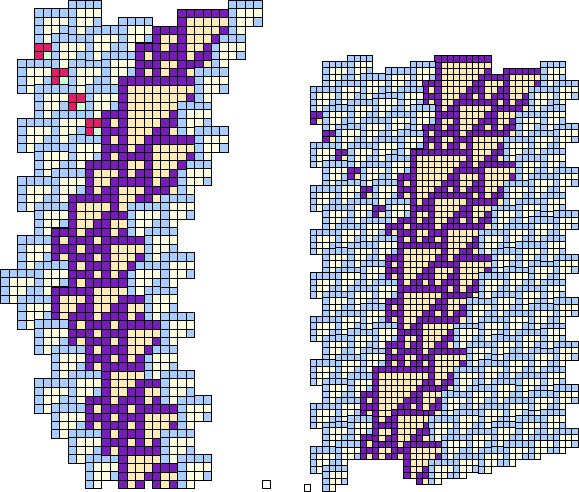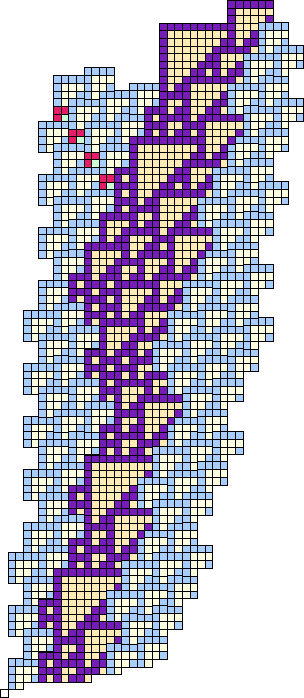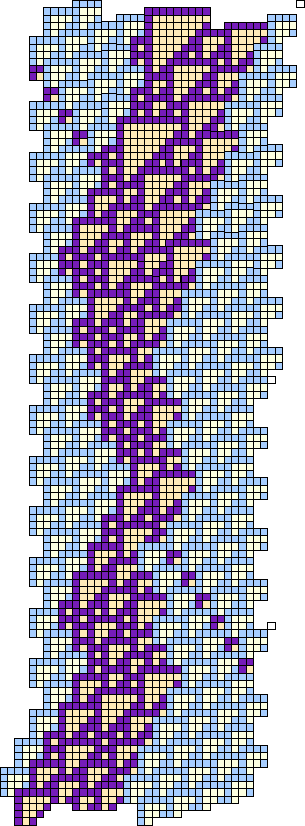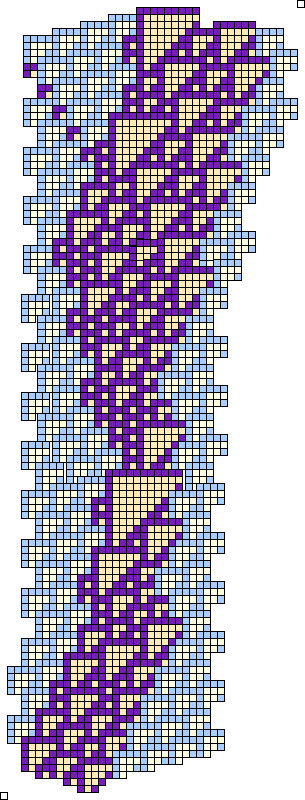



Next: nA - EBar collisions
Up: Collisions with A gliders
Previous: A - D collisions
Contents
There are three relative alignments at which A and E gliders may meet, which could be called high, medium, and low. Besides that, since the E glider is extensible, there is a whole infinity of E thicknesses, which are actually paddings with  gliders. Therefore, the discussion of A-E collisions turns into a survey of
gliders. Therefore, the discussion of A-E collisions turns into a survey of  demolitions.
demolitions.
Table 3.7:
A mid-collisions with En are periodic, repeating every time n increases by 16, with the proviso that an additional B glider is always produced every time n increases by 8.
| n |
main |
extra |
n |
main |
extra |
| 1 |
D1 |
. |
17 |
D1 |
2B |
| 2 |
E1 |
. |
18 |
E |
2B |
| 3 |
EBar |
A |
19 |
EBar |
A, 2B |
| 4 |
EBar |
. |
20 |
EBar |
B |
| 5 |
EBar |
B |
21 |
EBar |
2B |
| 6 |
F |
B |
22 |
F |
2B |
| 7 |
C1 |
B |
23 |
C1 |
2B |
| 8 |
C2 |
B |
24 |
C2 |
2B |
| 9 |
D1 |
B |
25 |
D1 |
2B |
| 10 |
EBar |
2A, B |
26 |
EBar |
2A, 3B |
| 11 |
E2 |
B |
27 |
E2 |
3B |
| 12 |
EBar |
B |
28 |
EBar |
3B |
| 13 |
EBar |
2B |
29 |
EBar |
4B |
| 14 |
BBar + F |
B |
30 |
BBar + F |
3B |
| 15 |
BBar + F |
2B |
31 |
BBar + F |
4B |
| 16 |
C2 |
2B |
32 |
C2 |
4B |
|
When the A glider meets the  glider in the low position, the reaction is very clean, always resulting in
glider in the low position, the reaction is very clean, always resulting in  except that the nonexistent
except that the nonexistent  is a C3. Even so, the indexing is consistent because A collisions with C's lower their indices, C1 turning finally into an F.
is a C3. Even so, the indexing is consistent because A collisions with C's lower their indices, C1 turning finally into an F.
Figure 3.7:
Left: An A glider in a ``mid'' collision can be absorbed by an E glider which promptly transmutes into a D. Right: But in a different alignment, whatsoever E retracts, which makes a nice counterpart to the extension occasioned by B-E collisions.
 |
Figure 3.8:
An A glider can be absorbed by an E2 which then reverts to an E1.
 |
Figure 3.9:
An A glider can be absorbed by an E3 which thereupon reverts to an EBar rather than to an E2, emitting a rightrunning A in the process. The alternatve result is due to the different relative alignment of the oncoming A.
 |
Figure 3.10:
An A glider can be absorbed by an E4 which reverts to a BBar rather than to an extended E. Note the isolated T10, which is a sure precursor of the EBar.
 |




Next: nA - EBar collisions
Up: Collisions with A gliders
Previous: A - D collisions
Contents
Jose Manuel Gomez Soto
2002-01-31
![]() gliders. Therefore, the discussion of A-E collisions turns into a survey of
gliders. Therefore, the discussion of A-E collisions turns into a survey of ![]() demolitions.
demolitions.
![]() glider in the low position, the reaction is very clean, always resulting in
glider in the low position, the reaction is very clean, always resulting in ![]() except that the nonexistent
except that the nonexistent ![]() is a C3. Even so, the indexing is consistent because A collisions with C's lower their indices, C1 turning finally into an F.
is a C3. Even so, the indexing is consistent because A collisions with C's lower their indices, C1 turning finally into an F.


